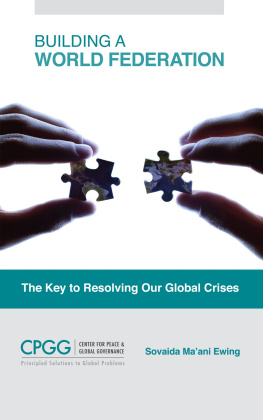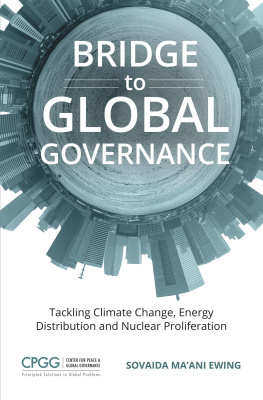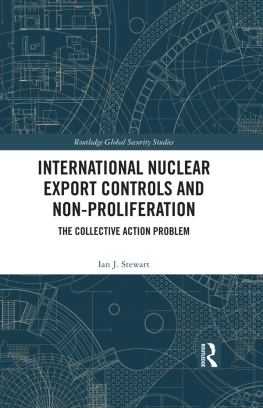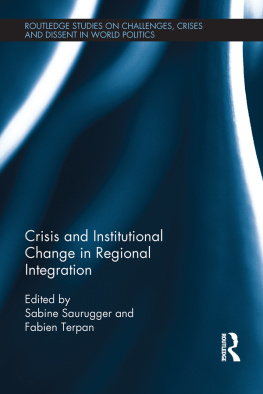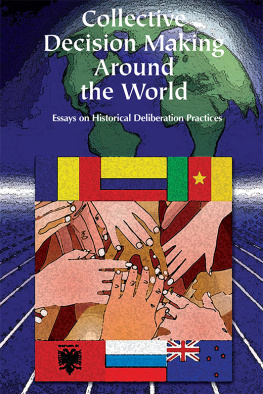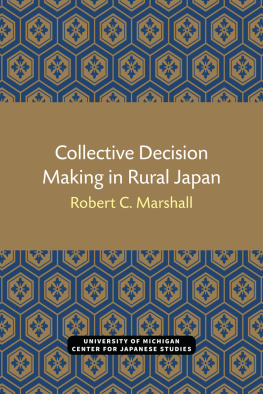Copyright
Copyright 2015 by Sovaida Maani Ewing
All Rights Reserved
Cover design: Reza Mostmand
ISBN 978-0-9909437-0-9
Also available as an e-book
ISBN 978-0-9909437-1-6
Published by the Center for Peace and Global Governance, Washington, DC.
Printed in the United States.
Introduction
Humanity, viewed as a collective whole, has been slowly but inexorably moving towards increasing integration. It has successively passed through stages of collective growth characterized by ever-widening circles of integration, social cohesion and loyalty starting with the family and progressing in turn to the tribe, city-state and nation. Given our tremendous advances in the areas of communication, transportation and trade that have made us increasingly and inextricably interdependent, it stands to reason that the next unit of overarching loyalty towards which we are moving is loyalty to the world as a unit. The peacefulness of our societies, which in turn determines the extent to which we can focus our energies on civilization-building activities, is largely determined by the degree of our social cohesion. Yet our progress toward peacefulness has always been uneven. Occasionally we have made great strides and produced impressive and peaceful civilizations. At other times we have not only failed to progress but have retrogressed. The overarching result, however, is one of growth in the direction of increasing integration and unity.
If we were to liken humanitys growth to that of an individual, then our current collective state might best be identified with the period of adolescence, with all its turbulence, exploration of boundaries and flirtation with dangerous and potentially disastrous behavior. Looking on the bright side, adolescence presages maturity, a fact that marks the momentous nature of our current experience and that should give us hope that we will emerge from our current seemingly chaotic and self-destructive state and display some of the much-anticipated evidences of maturity. The hope thus engendered can also galvanize us to expend the effort we need to navigate us through this critical period of adolescence in a way that minimizes the damage we do to ourselves. The hallmark of our collective maturity will be arriving at the next inevitable stage in our collective evolution, namely that of recognizing that our first allegiance must be to the human race as a whole. Having achieved this recognition, we will need to take the second step to craft global institutions and collective decision-making processes that reflect our newfound understanding.
Many factors point to the need for and timeliness of this next step: the first is the reality that in all spheres of lifebe they economic, financial, environmental, security or health to name but a fewnations and peoples are inextricably interconnected. Our modern systems of communication, transportation, trade and finance ensure that we live in a world in which one nation can no longer isolate itself from the concerns of other nations and claim that it is self-sufficient, because like it or not, it is not so. Our interests are too inextricably interwoven. Events in one part of the world can affect us all. Little did we expect for example, that a massive earthquake off the Tohuku east coast of Japan in March 2011 would set off a chain of events beginning with a 15-meter tsunami that would cause scientists to be concerned about the potential damage to human and biological health along the West Coast of Canada and the United States. Yet, the tsunami knocked out power to cooling pumps at the site of a nuclear power plant in the Fukushima-Daiichi prefecture leading to a partial meltdown of three of the plants four reactors and the subsequent release of large amounts of radioactive material, particularly cesium, into the waters of the Pacific Ocean. It was the worry triggered by such large releases that led scientists to put in place a program to monitor the coastal waters of North America on a periodic basis.
Another factor is the reality that the gravest problems facing humanity are collective in nature and demand collective solutions. Global warming is a prime example. Caused by the release into the biosphere of excessive amounts of greenhouse gases, chief among them carbon dioxide generated everywhere that fossil and other biological materials are burned for energy, the temperature of the earths surface is increasing at an historically unprecedented speed and triggering many kinds of damaging effects. These effects include melting glaciers and ice-caps that lead in turn to rising ocean levels that threaten to submerge entire island nations and large swathes of coastal areas around the world. As a result there will be less land to house growing populations and less arable land to feed them. Experts predict that these realities will inevitably lead to conflict over land and resources.
The proliferation of weapons of mass destruction including nuclear, chemical and biological weapons is another example of a global problem that demands a collective solution, inasmuch as it poses a threat to international peace and security. Such proliferation sows the seeds of fear and suspicion among nations leading them to amass arms in an ever-increasing quest to assure their own security. The greater the number of destructive armaments we amass and the higher the degree of fear, the greater are the chances that such weapons will be used deliberately or accidentally. Even if such armaments are ultimately used within a specific locality or region, experience teaches us that their use often has cascading and ever-widening, destabilizing effects on neighboring countries, regions and eventually beyond them to other nations.
The challenge of dealing with the behavior of rogue states that sponsor terrorism or commit genocide or other human rights atrocities on a large scale is yet another example of a global problem that calls for a collective solution. A good example that illustrates the regional and global ramifications of such problems can be seen in the single example of Syria. In a bid to quash internal dissent, the Syrian government began, in March of 2010, to use excessive force including chemical arms against its own people. By doing so, Syria triggered both a civil war and a severe refugee crisis that have resulted in one of the worst humanitarian crises of our times. More than three million Syrians have fled Syria as refugees.
Even problems that at first blush appear to be limited in their effect to one nation or region can quickly become matters of vital importance to the security of the world at large. Our recent history is replete with examples of rapidly spreading viruses like SARS, bird flu and Ebola that have the potential to become pandemics that threaten the well-being and survival of large numbers of human beings worldwide. The 2014 outbreak of the deadly Ebola virus in West Africa is the most recent example of this. Although initially viewed as a local or regional problem, six months after its outbreak, health officials began to express alarm at its rapid growth. They began to report that the virus was growing exponentially and started describing it as a potential threat to global security that needed to be dealt with swiftly and with force. Indeed, the community of nations concluded that the danger the virus posed to the international community was of such gravity, that it merited being taken up by the UN Security Council as a matter of urgency. Eventually, nations recognized that because of the degree of global interconnectedness, as evidenced by the amount of travel between nations, if a herculean effort was not made to stamp out the virus in West Africa, the scene of this latest outbreak, the virus would spread and threaten the security of people in other continents as well.

